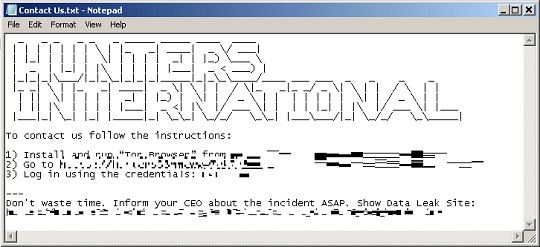Ransom.Win64.RUTHENS.THLABBC
UDS:Trojan-Ransom.Win64.Hive.a (KASPERSKY); Trojan.Ransom.Hunters.A (BITDEFENDER)
Windows


Threat Type: Ransomware
Destructiveness: No
Encrypted: No
In the wild: Yes
OVERVIEW
This Ransomware arrives on a system as a file dropped by other malware or as a file downloaded unknowingly by users when visiting malicious sites.
It drops files as ransom note. It avoids encrypting files with the following file extensions.
TECHNICAL DETAILS
Arrival Details
This Ransomware arrives on a system as a file dropped by other malware or as a file downloaded unknowingly by users when visiting malicious sites.
Installation
This Ransomware adds the following processes:
- wmic.exe shadowcopy delete
- bcdedit.exe /set {default} bootstatuspolicy ignoreallfailures
- wbadmin.exe delete systemstatebackup -keepVersions:3
- wbadmin.exe delete systemstatebackup
- bcdedit.exe /set {default} recoveryenabled No
- vssadmin.exe delete shadows /all /quiet
- wbadmin.exe delete catalog-quiet
- notepad.exe {Drive}:\Contact Us.txt
Process Termination
This Ransomware terminates the following services if found on the affected system:
- mepocs
- memtas
- veeam
- svc$
- backup
- sql
- vss
- msexchange
- vmm
- vmwp
It terminates the following processes if found running in the affected system's memory:
- encsvc
- thebat
- mydesktopqos
- xfssvccon
- firefox
- infopath
- winword
- steam
- synctime
- notepad
- ocomm
- onenote
- mspub
- thunderbird
- agntsvc
- sql
- excel
- powerpnt
- outlook
- wordpad
- dbeng50
- isqlplussvc
- sqbcoreservice
- oracle
- ocautoupds
- dbsnmp
- msaccess
- tbirdconfig
- ocssd
- mydesktopservice
- visio
Other Details
This Ransomware does the following:
- It accepts the following argument:
- -c {username}:{password} → Required. Specifies the username and password to access the contact page
- -a, -attach, --attach → Enables logging
- -A, -no-aggressive, --no-aggressive → Disables the deletion of backups and recovery
- -E, -no-extension, --no-extension → Disables appending of extension to files
- -m, -min-size, --min-size → Specifies the minimum file size for encryption (in bytes)
- {File or Path to encrypt} → Encrypts a specific file or directory
- It encrypts fixed, removable, and network drives.
Ransomware Routine
This Ransomware avoids encrypting files with the following strings in their file name:
- autorun.inf
- bootfont.bin
- boot.ini
- bootsect.bak
- desktop.ini
- iconcache.db
- ntldr
- ntuser.dat
- ntuser.dat.log
- ntuser.ini
- thumbs.db
- Contact Us.txt
It avoids encrypting files with the following strings in their file path:
- perflogs
- appdata
- $windows.~bt
- windows.old
- $windows.~ws
- msocache
- mozilla
- tor browser
- $recycle.bin
- windows
- windows nt
- intel
- all users
- internet explorer
- default
- boot
- system volume information
- config.msi
It appends the following extension to the file name of the encrypted files:
- {original filename}.{original extension}.locked
It drops the following file(s) as ransom note:
- {Encrypted Directory}\Contact Us.txt
- {Drive}:\Contact Us.txt

It avoids encrypting files with the following file extensions:
- 386
- adv
- ani
- bat
- bin
- cab
- cmd
- com
- cpl
- cur
- deskthemepack
- diagcab
- diagcfg
- diagpkg
- dll
- drv
- exe
- hlp
- hta
- icl
- icns
- ico
- ics
- idx
- key
- ldf
- lnk
- lock
- mod
- mpa
- msc
- msi
- msp
- msstyles
- msu
- nls
- nomedia
- ocx
- pdb
- prf
- ps1
- rom
- rtp
- scr
- shs
- spl
- sys
- theme
- themepack
- wpx
SOLUTION
Step 1
Trend Micro Predictive Machine Learning detects and blocks malware at the first sign of its existence, before it executes on your system. When enabled, your Trend Micro product detects this malware under the following machine learning name:
-
Troj.Win32.TRX.XXPE50FFF075
Step 2
Before doing any scans, Windows 7, Windows 8, Windows 8.1, and Windows 10 users must disable System Restore to allow full scanning of their computers.
Step 3
Note that not all files, folders, and registry keys and entries are installed on your computer during this malware's/spyware's/grayware's execution. This may be due to incomplete installation or other operating system conditions. If you do not find the same files/folders/registry information, please proceed to the next step.
Step 4
Search and delete these files
- {Encrypted Directory}\Contact Us.txt
- {Drive}:\Contact Us.txt
Step 5
Scan your computer with your Trend Micro product to delete files detected as Ransom.Win64.RUTHENS.THLABBC. If the detected files have already been cleaned, deleted, or quarantined by your Trend Micro product, no further step is required. You may opt to simply delete the quarantined files. Please check the following Trend Micro Support pages for more information:
Did this description help? Tell us how we did.


